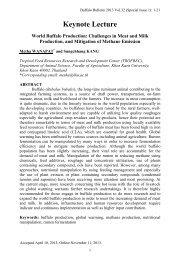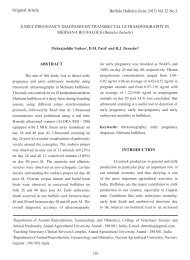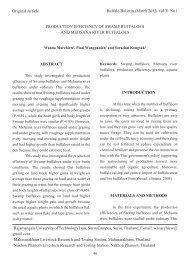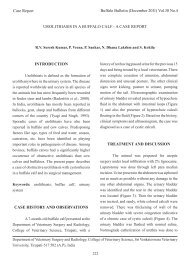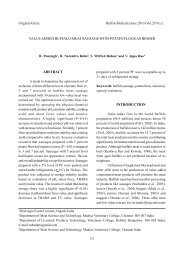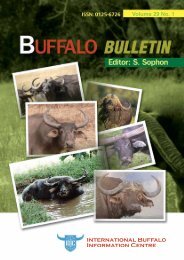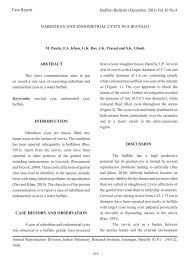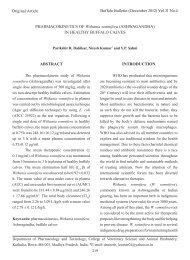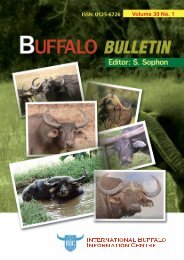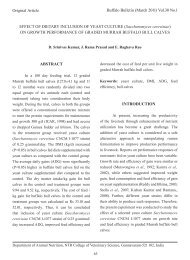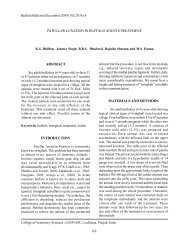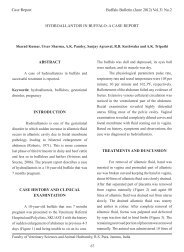DYSTOCIA DUE TO A CONJOINED TWIN MONSTER IN A BUFFALO
DYSTOCIA DUE TO A CONJOINED TWIN MONSTER IN A BUFFALO
DYSTOCIA DUE TO A CONJOINED TWIN MONSTER IN A BUFFALO
- No tags were found...
Create successful ePaper yourself
Turn your PDF publications into a flip-book with our unique Google optimized e-Paper software.
Case ReportBuffalo Bulletin (September 2010) Vol.29 No.3<strong>DYS<strong>TO</strong>CIA</strong> <strong>DUE</strong> <strong>TO</strong> A <strong>CONJO<strong>IN</strong>ED</strong> <strong>TW<strong>IN</strong></strong> <strong>MONSTER</strong> <strong>IN</strong> A <strong>BUFFALO</strong>A. Jerome 1, T. Sarath 1 and N. Arunmozhi 2ABSTRACTA conjoined twin monster fetus wasdelivered by per-vaginum in a pluriparous buffalo,which was presented with dystocia. The twinmonster consisted of two female fetuses whichwere fully developed having eight limbs, i.e. fourforelimbs and four hind limbs, joined together atthe anterior part of the body. The monster can beclassified as conjoined twin monster (Thoracoabdominopygophagus).Keywords: conjoined twin monster, buffalo<strong>IN</strong>TRODUCTIONConjoined twins are the most commoncause of dystocia in cattle and buffalo. Conjoinedtwins develop when incomplete separation occursafter the development of the embryonic plateat 8 days. Depending upon the site of fusion ornonseparation, the types of the twins may differ.Varying degrees of fusion occur but anteriorduplication is more often seen in ruminants andswine (Arthur, 1956). Monsters consisting of twofetuses or more joined together are common incow and buffalo (Sane et al., 1971). Structural ornumerical duplication during the embryonic stagegive rise to fetuses whose body structures arepartially but not completed duplicated (Roberts,1971). Conjoined twins arise from a single ovumand are monozygotic. Hancock (1954) and Arthur(1956) reported its occurrence to be about one in100,000 bovines’ births. This paper reports a caseof dystocia caused by a conjoined twin monster ina female buffalo.CASE HIS<strong>TO</strong>RYA buffalo female aged 6 years was broughtPochampalli Veterinary Dispensary, Krishnagiridistrict, Tamilnadu, with the history of completionof full term pregnancy but with no parturitionhaving occurred. The animal had completed onelactation, and the calving was reported to be normal.The animal had been straining for the previous fivehours since the expulsion of the first water bag eighthours before. Per vaginal examination revealedfully dilated cervix and a conjoined twin monsterattached at the trunk region. The monster was deadand was in anterior longitudinal presentation sacroileal position with two forelimbs in the birth canal.Head palpated at the birth canal showed abnormalformation, and it was deduced that dystocia wasdue to the dead fetal monster exhibiting posturaldefects of the extremities.1Division of Animal Reproduction, Indian Veterinary Research Institute, Izatnagar, Bareilly-243122 (U.P.),India2Department AGRO, TANUVAS India229
Buffalo Bulletin (September 2010) Vol.29 No.3After epidural anesthesia with 2%lignocaine hydrochloride, both the fore limbswere fastened to the snare and traction wasapplied after lubricating the birth canal withobstetrical gel. The fore limbs were extendedtowards the vulva, by traction on fetal trunkand other limbs simultaneously on forward anddownward direction, the dead female monstertwin fetuses were delivered.GROSS APPEARANCE OF THE<strong>MONSTER</strong>attached posterior to the umbilical region, andtwo tails. External genitalia were present. Therewas atresia ani and four teats were present, twoon each were present. The small intestine wasexposed through umbilicus (Figure 1). Thegross appearance of the conjoined twin was liketwo separate calves in the same direction. Themonster was a typical Siamese twin as per theclassification of Roberts (1971) in which partialduplication occurs at both cranial and caudal ends.<strong>IN</strong>TERNAL ORGANSThe monster was a conjoined twin withfusion at the anterior abdomen. The features werefully developed at the posterior region and notat the anterior region. It weighed 50 kg and hadan abnormally developed head. The head lackeddistinct eyes and mouth parts. There were twopairs of fore limbs, two pairs of hind limbs, twothoraxes, two trunks, each with both abdomensOn post-mortem examination, the conjoinedtwin monster was found to be attached to the anteriorabdomen. In the right calf, the diaphragm wasfully developed. Thoracic viscera included a pairof normal lungs and normal heart. The abdominalviscera like the intestine, kidneys, gall bladder andliver were normal. The urogenital organs wereabsent. In the left fetus, the thoracic viscera like theFigure 1.230
Buffalo Bulletin (September 2010) Vol.29 No.3lungs and heart were absent. The spleen, liver, andkidney were underdeveloped. The small intestinewas present, but the small intestine of both fetusesjoined, and the large intestine was common forthe twins. Atresia ani was found in both the twins.CAUSEConjoined twins may be caused by anynumber of factors, being influenced by genetic,environmental, and infectious agents. These factorsare responsible for the failure of twins to separateafter the 13 th day after fertilization. Moreover, calvesproduced by assisted reproductive techniques suchas IVF and ICSI may be a factor (Romero et al.,1988).DISCUSSIONTwins are monozygotic in origin, and are,moreover, due to incomplete division of one embryointo two components usually at the primitive streakdevelopment state (Noden and Delahunta, 1985).Conjoined twins are non-inherited teratologicdefects. Such abnormal embryonic duplicationsresulting in conjoined twins are rare and not welldocumented in buffaloes. Urankar et al. (1994)reported a conjoined twin monstrosity in a buffalo.The present case seems to be a non-inheritedteratogenic defect of development since there wasno history of monster birth in the previous fourcalvings. Dystocia due to conjoined twin monsters,though uncommon, has been reported earlier inbuffalo (Urankar et al., 1994; Dhami et al., 2000)and in cow (Honnappagol et al., 2005). The presentcase is the first of its kind in buffaloes since thereis no report of dystocia due to complete duplicationof the entire fetal body.REFERENCESArthur, G.H. 1956. Conjoined and identical twins.Vet. Rec., 68: 389.Dhami, A.J., M.T. Panchal and F.S. Kavani. 2000.Dystocia due to holo acardius acephalic(Asymmetrical conjoined twin) monster in abuffalo. Indian J. Anim. Reprod., 21(2): 162-164.Hancock, J. 1954. Monozygotic twins in cattle.Advances in Genetics, 6: 141.Honnappagol, S.S., M.H. Tandle andV. Ramakrishna. 2005. Thoraco abdominopygophagusfoetal monster in anon-descript cow. Indian Vet. J., 82: 441.Noden, D.M. and A. De Lahunta. 1985. TheEmbryology of Domestic Animals. Williamsand Wilkins, Baltimore, p. 44-45.Roberts, S.J. 1971. Veterinary Obstetrics andGenital Diseases, 2 nd ed. Scientific BookAgency, Lucknow, India.Romero, R., G. Pilu and P. Jeanty. 1988.Prenatal Diagnosis of Congenital Anomalies.Norwalk, CT, Appleton and Lange, p. 405-409.Sane, C.R., S.N. Luktuke, A.S. Kaikini, V.B.Hukeri, B.R. Deshpande, D.P. Velhnkar,S.B. Kodagali and V.B. Deopukar. 1994.Reproduction in Farm Animals, 2 nd ed.Verghese Publishing House, Mumbai, p. 95.Urankar, R.M., S.V Chhonkar and P.M. Gangaprai.1994. Conjoined twin monstrosity in abuffalo. Indian J. Anim. Reprod., 15(2): 165.231



